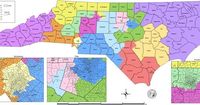North Carolina has once again found itself at the center of America’s redistricting battles, as Republican leaders unveiled a new congressional map on October 16, 2025, rekindling fierce partisan debate and setting the stage for a likely legal showdown. The proposed changes, which will be debated by state lawmakers next week in Raleigh, are designed to solidify Republican control of the U.S. House by making it far more difficult for Democrats to win in the state’s only competitive congressional seat.
The new map, announced by the chairs of North Carolina’s Senate and House redistricting committees, would dramatically reshape the 1st and 3rd congressional districts. The 1st District, currently represented by Democrat Don Davis, would lose four counties—including Wayne and Wilson—but would gain six others: Dare, Hyde, Pamlico, Carteret, Craven, and Beaufort. These are all historically Republican counties, and the shift is expected to transform the 1st District from a toss-up into a Republican-leaning stronghold. Meanwhile, the 3rd District, held by Republican Greg Murphy, would absorb Wayne, Lenoir, Greene, and Wilson counties, while ceding the six coastal counties to the 1st.
According to data provided by the legislature, the newly drawn 1st District would have voted 55% for Donald Trump and 44% for Joe Biden in the 2024 presidential election. That’s a significant shift from its current status as the state’s only swing seat, where Davis managed to eke out a reelection victory in 2024 by less than two percentage points. The new lines, in effect, put Davis at a more than 10 percentage point deficit, making his path to reelection extremely steep.
This is not the first time Republicans have attempted to redraw Davis’s district. After a 2023 map tilted the district slightly Republican, Davis still managed to win in 2024, albeit narrowly. The latest proposal represents the GOP’s second attempt in as many years to unseat him by redrawing boundaries. The 11th District, held by Republican Chuck Edwards, would become the state’s most competitive under the new plan, but even there, Republicans would hold a nearly 10-point advantage based on the 2024 presidential results. If passed, North Carolina would have no swing districts left—every seat would be solidly in one party’s column.
The timing and intent of the redistricting effort are no secret. Republican leaders, including House Speaker Destin Hall and Senate President Pro Tem Phil Berger, have been explicit that the map is a response to President Donald Trump’s nationwide call for GOP-led states to redraw districts and help maintain Republican control of Congress in the 2026 midterms. “President Trump earned a clear mandate from the voters of North Carolina and the rest of the country, and we intend to defend it by drawing an additional Republican Congressional seat,” Hall said in a statement on Monday, as reported by NC Newsline. Berger echoed the sentiment on social media: “The #NCGA is ready to help Republicans secure Congress and move @realDonaldTrump’s agenda forward!”
The move is part of a broader national arms race over redistricting. After Texas Republicans passed a new congressional map, California Democrats responded by drawing their own, with both parties seeking to maximize their advantage ahead of 2026. North Carolina’s new proposal is the latest salvo in this ongoing battle, and it comes as the state’s Republican-controlled legislature embarks on its fifth redistricting effort in six years. According to NOTUS, these repeated redraws have already cost North Carolina taxpayers nearly $3 million in litigation since 2021, and another round of expensive court fights appears inevitable.
Democratic leaders, both in North Carolina and nationally, have condemned the new map as a blatant power grab. The Democratic National Committee called the redistricting efforts “corruption at its worst,” with DNC Chair Ken Martin accusing Senate leader Phil Berger of securing “his own dishonest backroom deal” at the expense of North Carolinians. State House Democratic Leader Robert Reives labeled the move “stealing a congressional district,” while Governor Josh Stein charged that Republicans are “failing you, the voters.” In a statement, Stein said, “These shameless politicians are abusing their power to take away yours. I will always fight for you because the voters should choose their representatives, not the other way around.”
Local Democratic representatives were equally outspoken. “They’re trying to steal another district away from the Democrats,” said Rep. Deborah Ross, according to NOTUS. “When we’re a purple state, we should have pretty much evenly divided congressional delegation, and they are going to have politicians choosing their own voters, rather than voters choosing their elected representatives.” Rep. Valerie Foushee added that mid-decade redistricting “makes no sense, and it’s unfair.”
Republicans, for their part, argue that the effort is justified as a way to support Trump’s agenda and secure the party’s slim majority in the U.S. House. Matt Mercer, communications director for the North Carolina Republican Party, told NOTUS, “There’s no reason not to jump into the fray and do everything we can to support President Trump and his agenda.” Some GOP officials have downplayed concerns about the cost and frequency of redistricting, instead blaming Democrats and left-leaning groups for the expensive litigation that follows each new map.
Despite the heated rhetoric, public opinion in North Carolina appears to be firmly against partisan gerrymandering. A September 2025 poll cited by NC Newsline found that 87% of Democrats and 78% of Republicans in the state oppose gerrymandering. Another survey found that 84% of North Carolinians believe it is an important democratic principle that district lines not consistently favor one party over the other. Yet, as political scientist Chris Cooper told NOTUS, “Once the maps are so locked in, there’s really no potential electoral punishment for doing that.”
Legal challenges are almost certain, but their prospects are uncertain. Courts have recently upheld partisan maps in North Carolina, and the U.S. Supreme Court is currently considering whether to further restrict the use of race in redistricting. If the new map is enacted, it could help Republicans pick up one more seat in the U.S. House, giving them 11 of North Carolina’s 14 congressional seats. The map requires only a simple majority to pass in the GOP-led General Assembly and is not subject to a veto by Democratic Governor Josh Stein, making its approval all but guaranteed.
For his part, Rep. Don Davis has maintained a measured tone. In a statement earlier this week, he said, “Serving the hardworking families of the East is my unwavering commitment, regardless of party affiliation or the way the map is drawn, and I intend to continue in this work. Eastern North Carolina is my home, and our residents deserve a champion and fair representation.” Greg Murphy’s office also expressed confidence, noting that he looks forward to continuing to serve Eastern North Carolina.
As lawmakers prepare to debate the new map next week, North Carolinians have been invited to submit public comments. But with the deck stacked by partisan majorities and the courts unlikely to intervene, many observers believe the outcome is already set. The battle over redistricting in North Carolina is just the latest chapter in a broader national struggle over who gets to draw the lines—and, ultimately, who gets to choose the nation’s leaders.


